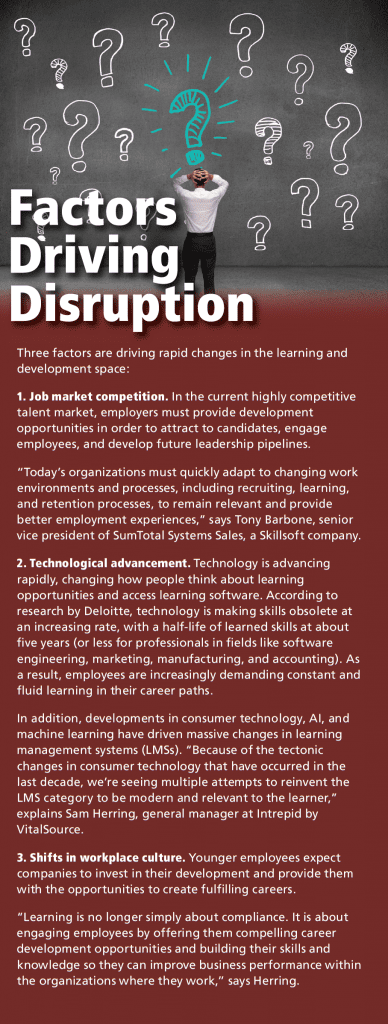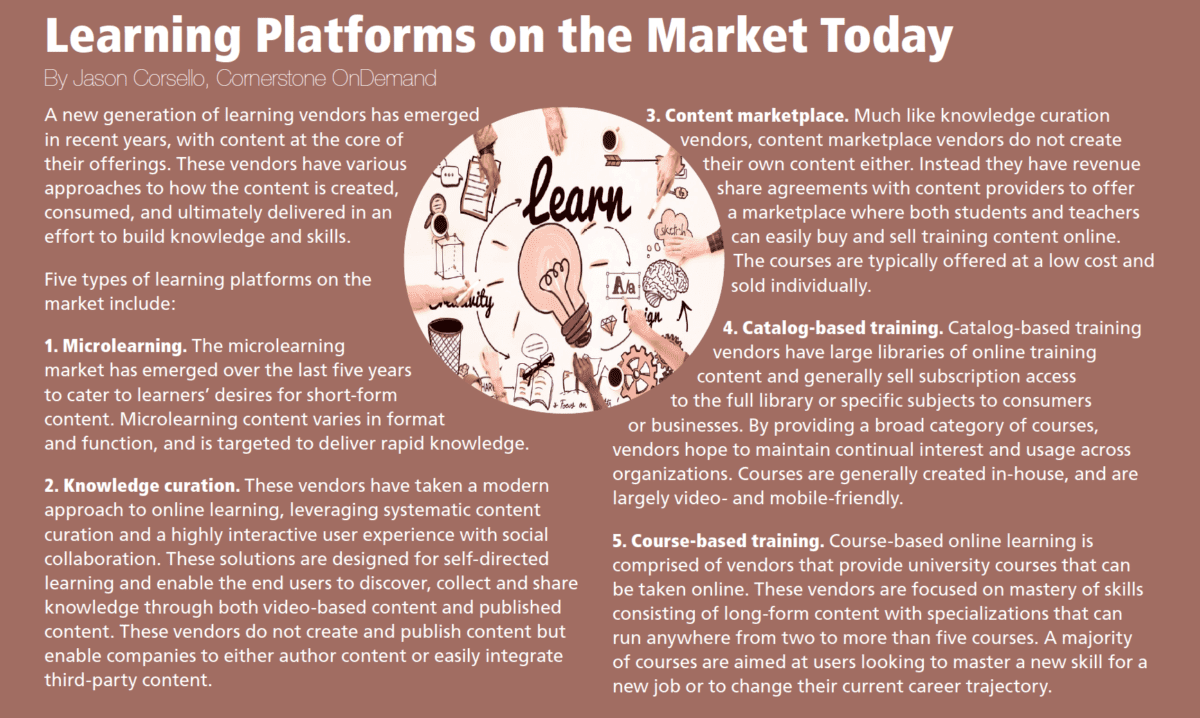A tight talent market and innovative technologies are driving organizations to engage in new ways of training.
By Marta Chmielowicz
For the past few years, the workplace has been in a period of massive disruption marked by shifting demographics, rapid technological advancement, and ever-increasing competition for top talent. In order to adapt to these conditions, business leaders have been forced to rethink the way they approach employee development and redesign their learning programs to be more agile and dynamic.
According to Deloitte’s 2017 Global Human Capital Trends Report, 83 percent of executives identify learning and development as important or very important -second only to building the organization of the future. This may be motivated by the fact that 90 percent of CEOs believe their company is facing disruptive change driven by digital technologies, and 70 percent report that their organization does not have the skills to adapt.
To conquer this disruption, embrace the new career demands of top talent, and establish themselves as employers of choice, organizations are going all in with their learning programs. This requires a shift toward a new approach to training that gives employees control over their own experience and fosters a culture of learning throughout the organization.
“One of the most significant shifts occurring in the market is adaptive learning,” says Amy Gurchensky, senior research analyst of HR at NelsonHall. “Adaptive learning is becoming increasingly important as organizations seek to leverage more informal training that is responsive to an individual learner’s needs.”
By tailoring course content in real-time to the strengths, weaknesses, and goals of individual users, adaptive learning technology helps employees learn more efficiently and effectively.
Leaving Behind the Traditional LMS
In shedding the old, static, internally-focused approaches to learning, organizations are beginning to embrace new technologies that allow for a highly personalized, collaborative, mobile learning experience. This is being aided by new types of learning management systems (LMSs).
 According to Iain Scholnick, CEO and founder of Braidio, new LMSs have evolved a long way from the traditional, rigid, course-based approach to learning. They now integrate collaboration and continuous learning for a better training experience.
According to Iain Scholnick, CEO and founder of Braidio, new LMSs have evolved a long way from the traditional, rigid, course-based approach to learning. They now integrate collaboration and continuous learning for a better training experience.
“People are taking the tools they’ve found in consumer experiences such as Facebook, LinkedIn, texting, and email, and have worked them together to enhance traditional learning management systems, which are very top-down types of systems,” he says.
LMSs are no longer merely compliance tools used to deliver courses to employees and status reports to management. “The starting point for learning experience platforms is the learner -not the administrator or manager -and not compliance or reporting,” says Sam Herring, general manager at Intrepid by VitalSource.
Herring says that some of the most popular features in new LMSs include:
- consumer-grade usability;
- collaboration and social engagement;
- personalization;
- opportunities for practice and application;
- mobile accessibility;
- the ability to support bite-sized learning such as video, gamification, and badging; and
- micro-credentialing.
What to Expect
Today’s LMSs embrace a modern way of work in both their delivery and execution through:
1. Active, on-demand learning. Employees today need easily accessible, precise, and relevant just-in-time learning solutions, driving LMSs to integrate mobile capabilities and microlearning.
“What we’re seeing is that [organizations] are trying to provide a more flexible framework for learning that really adjusts to how people work today,” says Braidio’s Scholnick. “What’s popular is having learning being driven by employees’ need for a just-in-time type of solution. How you work in your workday -that’s when you want your learning to occur, not to go offline for eight hours and take a course.”
He also says that in reality, employees can only dedicate one percent of their bandwidth weekly to absorb new information, so platforms need to deliver bite-sized content that is continuous and engaging.
“Providing opportunities and experiences that promote continuous learning is a growing necessity for many organizations looking to remain agile in today’s work environment. Rather than relying on older methods of structured learning, it’s important now for organizations to create an effective culture of continuous learning and deliver small chunks of relevant information in the context of your employees’ daily work life,” says Tony Barbone, senior vice president of sales at SumTotal Systems, a Skillsoft company.
To do this effectively, enabling learning on various systems and devices is key. “Engaging and responsive mobile design and notifications make it easy for every role to engage with the LMS on-the-go or from remote locations, whether online or offline, to ensure learning is prioritized and accessible when and how people prefer to consume it,” he explains.
2. Personalization. With the rise of AI and machine learning, LMS providers are increasingly “…leveraging their years of experience in adaptive technology and machine learning to deliver a highly-personalized user experience that encourages users to continue learning with personalized course recommendations based on their career path and trainings they previously completed,” says Jason Corsello, senior vice president of strategy and corporate development at Cornerstone OnDemand.
By delivering the right content at the right time, automating learning paths, and leveraging a consumer-like interface to deliver these experiences, Barbone believes that new LMSs are significantly improving employee empowerment and system adoption.
“The new user experience closely matches what consumers expect from technology and puts them in control of their career development, allowing for learning to occur in more natural ways as part of their daily work flow,” Corsello explains.
3. Social learning. Modern LMSs rely heavily on social learning and collaboration, allowing companies to circulate learning across the team so that employees can share each other’s problems and provide each other’s solutions. By formalizing the informal social learning experience that takes place between coworkers, Scholnick says that LMSs allow employees to work together to achieve common goals and objectives.
“Rather than trying to curate the answer yourself, you can put in some keywords and find previous answers, training videos, some articles you can read, microburst learning you can do from third-party content -it’s all in front of you in one place. In effect, it’s active knowledge assembly,” he explains.
This information can then be circulated back to the centralized systems of the company. “[This type of LMS] provides not only a social learning platform and a way to collaborate socially, but a way to circulate that learning among employees and let it be institutionalized back into the company databases,” says Scholnick.
In addition, the social component allows employees to screen training modules and deliver better learning paths. “Social collaboration and training ‘reviews’ are becoming very important to learners. It helps them decide if a training is worth their time. They can also see who else in their organization took specific courses and mimic those training paths,” says Corsello.
Another way employees get the most out of social learning is when it is gamified. “Gamification allows organizations to create fun, competitive environments in which employees compete in pursuit of their development,” says Barbone. “Leaderboards, badges, points, and other elements showcase individual development and compare it to colleagues’ progress. This fosters an encouraging environment for employees to achieve business goals and objectives, and increases employee engagement at all levels of the organization.”
Choosing an LMS
The LMS market is a crowded space, and with so many types of platforms available, organizations need to be sure that they accurately evaluate their needs and choose a platform that will most effectively deliver the type of learning they require.
“While traditional LMSs present role-based content, they have limitations actually deliveringrelevant content for each learner,” says Gurchensky. “The key for successfully delivering a truly adaptive experience is that all the infrastructure must be integrated. Therefore, buyers need to consider their long-term strategic training objectives to ensure that the LMS purchased today is suitable for their future direction, especially if adaptive learning is part of that strategy.”
But first, HR professionals need to assess the learning needs of their company and their desired outcomes. “Effectively, do a simple type of audit of what kind of content you want employees to know, what kind of outcomes you are looking for (customer success, HR, compliance, or revenue success), what are the most fundamental needs that you have to teach your employees, and to encourage learning around,” says Scholnick.
Armed with this information, organizations will be able to determine which type of technology will allow them to deliver a modern learning experience for their workers.
LEARN MORE
[metaslider id=10152]















